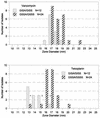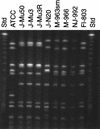Characterization of staphylococci with reduced susceptibilities to vancomycin and other glycopeptides
- PMID: 9542929
- PMCID: PMC104681
- DOI: 10.1128/JCM.36.4.1020-1027.1998
Characterization of staphylococci with reduced susceptibilities to vancomycin and other glycopeptides
Erratum in
- J Clin Microbiol 1998 Jul;36(7):2167
Abstract
During the last several years a series of staphylococcal isolates that demonstrated reduced susceptibility to vancomycin or other glycopeptides have been reported. We selected 12 isolates of staphylococci for which the vancomycin MICs were > or =4 microg/ml or for which the teicoplanin MICs were > or =8 microg/ml and 24 control strains for which the vancomycin MICs were < or =2 microg/ml or for which the teicoplanin MICs were < or =4 microg/ml to determine the ability of commercial susceptibility testing procedures and vancomycin agar screening methods to detect isolates with reduced glycopeptide susceptibility. By PCR analysis, none of the isolates with decreased glycopeptide susceptibility contained known vancomycin resistance genes. Broth microdilution tests held a full 24 h were best at detecting strains with reduced glycopeptide susceptibility. Disk diffusion did not differentiate the strains inhibited by 8 microg of vancomycin per ml from more susceptible isolates. Most of the isolates with reduced glycopeptide susceptibility were recognized by MicroScan conventional panels and Etest vancomycin strips. Sensititre panels read visually were more variable, although with some of the panels MICs of 8 microg/ml were noted for these isolates. Vitek results were 4 microg/ml for all strains for which the vancomycin MICs were > or =4 microg/ml. Vancomycin MICs on Rapid MicroScan panels were not predictive, giving MICs of either < or =2 or > or =16 microg/ml for these isolates. Commercial brain heart infusion vancomycin agar screening plates containing 6 microg of vancomycin per ml consistently differentiated those strains inhibited by 8 microg/ml from more susceptible strains. Vancomycin-containing media prepared in-house showed occasional growth of susceptible strains, Staphylococcus aureus ATCC 29213, and on occasion, Enterococcus faecalis ATCC 29212. Thus, strains of staphylococci with reduced susceptibility to glycopeptides, such as vancomycin, are best detected in the laboratory by nonautomated quantitative tests incubated for a full 24 h. Furthermore, it appears that commercial vancomycin agar screening plates can be used to detect these isolates.
Figures


Similar articles
-
Underestimation of vancomycin and teicoplanin MICs by broth microdilution leads to underdetection of glycopeptide-intermediate isolates of Staphylococcus aureus.Antimicrob Agents Chemother. 2010 Sep;54(9):3861-70. doi: 10.1128/AAC.00269-10. Epub 2010 Jun 14. Antimicrob Agents Chemother. 2010. PMID: 20547791 Free PMC article.
-
Proficiency of Italian clinical laboratories in detecting reduced glycopeptide susceptibility in Enterococcus and Staphylococcus spp. using routine laboratory methodologies.Clin Microbiol Infect. 2002 Feb;8(2):101-11. doi: 10.1046/j.1469-0691.2002.00378.x. Clin Microbiol Infect. 2002. PMID: 11952723
-
Susceptibility of Brazilian staphylococcal strains to glycopeptides evaluated by different testing methods.Curr Microbiol. 2002 Jun;44(6):385-90. doi: 10.1007/s00284-001-0027-3. Curr Microbiol. 2002. PMID: 12000986
-
Glycopeptide resistance in coagulase-negative staphylococci.Eur J Clin Microbiol Infect Dis. 2000 Jun;19(6):403-17. doi: 10.1007/s100960000299. Eur J Clin Microbiol Infect Dis. 2000. PMID: 10947214 Review.
-
Increasing resistance to vancomycin and other glycopeptides in Staphylococcus aureus.Emerg Infect Dis. 2001 Mar-Apr;7(2):327-32. doi: 10.3201/eid0702.010237. Emerg Infect Dis. 2001. PMID: 11294734 Free PMC article. Review.
Cited by
-
Strategic Moves of "Superbugs" Against Available Chemical Scaffolds: Signaling, Regulation, and Challenges.ACS Pharmacol Transl Sci. 2020 Apr 13;3(3):373-400. doi: 10.1021/acsptsci.0c00005. eCollection 2020 Jun 12. ACS Pharmacol Transl Sci. 2020. PMID: 32566906 Free PMC article. Review.
-
Intramuscular Injection Abscess Due to VRSA: A New Health Care Challenge.Arch Bone Jt Surg. 2016 Jun;4(3):277-81. Arch Bone Jt Surg. 2016. PMID: 27517077 Free PMC article.
-
Vancomycin treatment failure associated with heterogeneous vancomycin-intermediate Staphylococcus aureus in a patient with endocarditis and in the rabbit model of endocarditis.Antimicrob Agents Chemother. 2003 Apr;47(4):1262-6. doi: 10.1128/AAC.47.4.1262-1266.2003. Antimicrob Agents Chemother. 2003. PMID: 12654656 Free PMC article.
-
Underestimation of vancomycin and teicoplanin MICs by broth microdilution leads to underdetection of glycopeptide-intermediate isolates of Staphylococcus aureus.Antimicrob Agents Chemother. 2010 Sep;54(9):3861-70. doi: 10.1128/AAC.00269-10. Epub 2010 Jun 14. Antimicrob Agents Chemother. 2010. PMID: 20547791 Free PMC article.
-
Methicillin-resistant, quinupristin-dalfopristin-resistant Staphylococcus aureus with reduced sensitivity to glycopeptides.J Clin Microbiol. 2001 Oct;39(10):3586-90. doi: 10.1128/JCM.39.10.3586-3590.2001. J Clin Microbiol. 2001. PMID: 11574577 Free PMC article.
References
-
- Aarestrup F M, Ahrens P, Madsen M, Pallesen L V, Poulsen R L, Westh H. Glycopeptide susceptibility among Danish Enterococcus faecium and Enterococcus faecalis isolates of animal and human origin and PCR identification of genes within the VanA cluster. Antimicrob Agents Chemother. 1996;40:1938–1940. - PMC - PubMed
-
- AB Biodisk America Inc. Etest package insert. Piscataway, N.J: AB Biodisk North America Inc.; 1996.
-
- Archer G L, Auger P, Doern G V, Ferraro M J, Fuchs P C, Jorgensen J H, Low D E, Murray P R, Reller L B, Stratton C W, Wennersten C B, Moellering R C., Jr RP 59500, a new streptogramin highly active against recent isolates of North American staphylococci. Diagn Microbiol Infect Dis. 1993;16:223–226. - PubMed
-
- Barna J C, Williams D H. The structure and mode of action of glycopeptide antibiotics of the vancomycin group. Annu Rev Microbiol. 1984;38:339–357. - PubMed
MeSH terms
Substances
LinkOut - more resources
Full Text Sources
Other Literature Sources
Medical
Molecular Biology Databases

